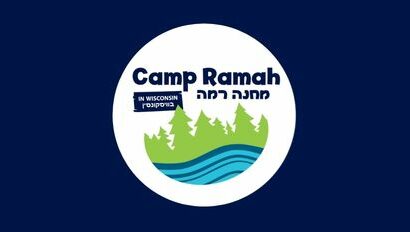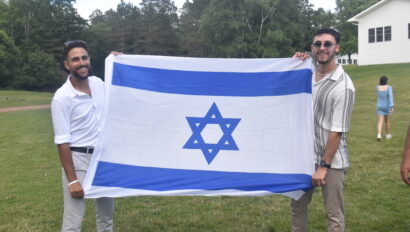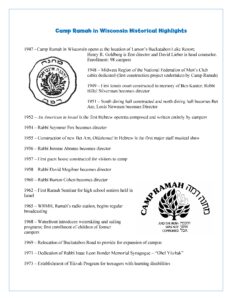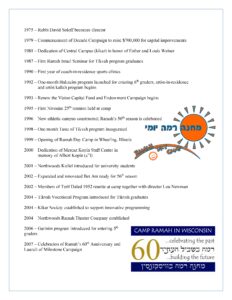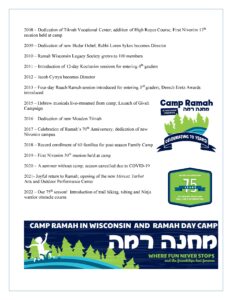Last week, one of the secrets of our Ramah Wisconsin “magic” was revealed, in the most unlikely of places: through a discussion of the Higgs Boson and the Book of Job.
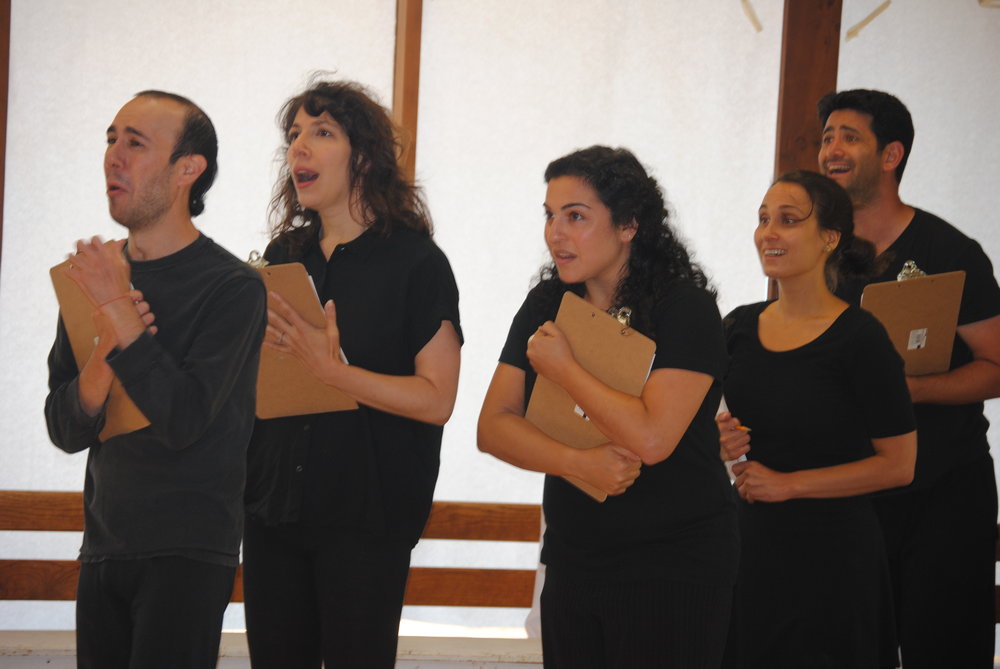
We just concluded the 10th annual residency of one of Ramah in Wisconsin’s hidden gems, our professional theatre troupe known as the Northwoods Ramah Theatre Company (NRTC). Since 2005, the troupe, led by founding director Annie Levy, has come to camp to incubate at least one new project of experimental Jewish theatre. Utilizing a variety of avant-garde tools in the world of contemporary performing arts, Annie and her team of actors tackle a topic, text, or script, and help it come alive over the course of what is usually a two-week residency. Over the years they have interpreted “The Jewbird” by Bernard Malamud; poetry by Jewish poets Rachel, Shel Silverstein, and Charles Reznikoff; Shakespeare’s The Merchant of Venice; Hasidic fables; and more. Supported this year by a generous grant from the Covenant Foundation, we have been working to bolster our existing programming around the NRTC and to imagine what the future may hold. In doing so, we have drilled down to the basics, including supplementing our efforts to have campers’ experience the NRTC in its completely unique approach to an artistic residency: open rehearsals. Throughout the two weeks, our director and actors were working together to create theatre in our Seminar Center, with doors and windows open. Over the course of the two weeks, perhaps 75% of all campers spend at least some time watching a rehearsal, engaging in the process of creating art, and in doing so they are invited to explore, to ask questions, and to share feedback.
 The show this year was a whimsical and playful meditation on how we make order out of chaos and its two major source texts were a translation of the Biblical Book of Job and multimedia materials surrounding the research efforts over the last few years to find the Higgs boson subatomic particle. The show, which all of our campers except for Halutzim had an opportunity to see on Thursday during one of three performances, was engaging and splendid, taking advantage of a new programming space in our Sifriyah (library). It included juggling, hilarious accents, and some amazing and accessible metaphors for some of the most complicated questions in theoretical and experimental physics (skiing a mountain to represent the mass of an object; an orange to represent an atom).
The show this year was a whimsical and playful meditation on how we make order out of chaos and its two major source texts were a translation of the Biblical Book of Job and multimedia materials surrounding the research efforts over the last few years to find the Higgs boson subatomic particle. The show, which all of our campers except for Halutzim had an opportunity to see on Thursday during one of three performances, was engaging and splendid, taking advantage of a new programming space in our Sifriyah (library). It included juggling, hilarious accents, and some amazing and accessible metaphors for some of the most complicated questions in theoretical and experimental physics (skiing a mountain to represent the mass of an object; an orange to represent an atom).
What makes the NRTC unique makes all of Ramah Wisconsin unique: our entire campus is just a massive open rehearsal–for performances, for Jewish ritual, for life. Throughout the summer our afternoons are filled with the sounds of chorus numbers from each of our six musical performances floating through the air around the Bet Am. Many of our campers listen to their cabin-mates practice Torah readings or Haftorahs or Bat Mitzvah projects or lines in the musical or pieces of music over the course of days and weeks. Our basketball and softball teams practice in full view of anyone who cares to walk by; as do our runners and tennis players. The moment of performance is an important one, but the many moments that lead up to that moment help create the social bonds that make the performance meaningful. In so much of our lives, we are obsessed with the final product; at Ramah Wisconsin it is all about the meandering, not-so-neat process–the product is just an excuse to exult at all the hard work we have literally seen be invested in whatever project we are undertaking.

The NRTC show also magically tied together two of American Judaism’s most treasured thinkers, each with strong connections to Ramah Wisconsin and to each other. For years one of Ramah Wisconsin’s most distinguished alumni, Professor Lee Shulman, and the Jewish Theological Seminary of America’s current Chancellor, Professor Arnie Eisen, attended synagogue together in Palo Alto, CA. Rumors are they used to sit near or next to each other. Eisen, who visited us a few weeks ago and taught us much, routinely speaks about what attracts him to Conservative Judaism: an invitation to bring everything human beings know about the world–science–in dialogue with our Jewish sources, ideas, values, and religion. Watching the actors move back and forth between the “experiment” that divine beings conduct on Job and the scientific experiments at the Large Hadron Collider near Geneva, Switzerland, it was hard not to think about Eisen’s vision for what makes Conservative Judaism’s approach to Judaism and the world so compelling. Shulman, former president of the Carnegie Foundation for the Advancement of teaching and a revered Professor of Education at Michigan State and Stanford Universities over his career, taught years ago about what he believes to be the singular pedagogy of Judaism: the way Jews truly learn to be Jews. His secret to Jewish continuity is that we must help our children realize that Jewish texts are their heritage and that it is every generation’s responsibility to continue the interpretive tradition of those texts, to say something new, original, and truly theirs about the Jewish library that is theirs to own and on which they must leave their mark. Just as Eisen’s teaching came true through the NRTC’s performance, so too did Shulman’s, as through the performance each audience member bore witness to this process happening before our eyes and, as such, were compelled to enter into the process for ourselves.
As Abraham Joshua Heschel and others have suggested, the creation of new knowledge is divine revelation. At Ramah in Wisconsin we work to empower our campers and staff around their textual, ethical, and ritual inheritances, and then we model for them, nudge them, and help them gain skills in digesting those gifts from our ancestors and recreating them for the world in which they live. It just so happened that the NRTC performances on Thursday happened to be about perhaps the most important creation of new knowledge human civilization has produced in the last few years. For, as we know so well at Ramah, it is not actually the content of the performance that ultimately matters but the form that produces that content. And in that regard, the NRTC is just the most obvious example today of a microcosm of everything we do here to advance nothing less than an ambitious agenda for how Judaism is to thrive in the constantly-developing twenty-first century.That is the inheritance of the founding generation of visionary Ramah educators, like Rabbi Dr. Seymour Fox and Louis Newman, two of Lee Shulman’s most important intellectual and educational influences. That, too, is the gift our new generation of educators seeks to provide your children, your families, your communities, and the entire Jewish world.
by Jacob Cytryn, Director
